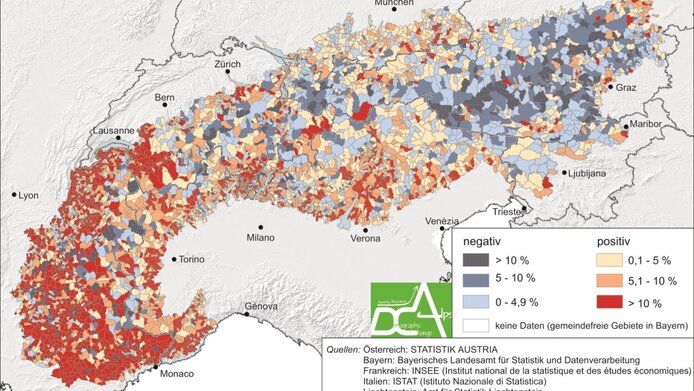The Alps between depopulation and gentrification

By now, a hefty share of the world’s population – more than 50 percent – lives in cities. Rural areas and mountain villages suffer from ageing populations, and formerly well-tended countryside becomes overgrown. A team headed by Ernst Steinicke from the Department of Geography at the University of Innsbruck has, however, registered a small but distinct reverse trend that started a few years ago. “Amenity migration” is a notion the principal investigator first noticed in the Californian Sierra Nevada (USA). Amenity migrants are people who buy an out-of-town second home because they are looking for amenities such as security, seclusion and a beautiful landscape. In the Alps, the migration movement from cities to the mountains is not just by amenity seekers, but it is more closely related to what the French call néo-ruralisme – loosely translated as “a new love of country life”. Even in remote areas, marked by depopulation, low birth rates and a high average age, “the statistics show fluctuations in the population. There is an exchange going on, in some places even a kind of Alpine gentrification”, stresses Ernst Steinicke in the interview with scilog. Quite often the “new highlanders” join in this urban exodus for the long term. Involving various segments of the population, this trend is affordable for more people because of low housing prices in peripheral regions. With the support of the Austrian Science Fund FWF, a team of researchers conducted human-geography case studies focusing on the ongoing demographic turnaround in the Alps. The team investigated 70 areas with pronounced outflows and inflows. In their detailed work they mapped 25 valleys and villages in Slovenia, France, Italy and East Tyrol on the basis of parameters such as type of dwelling, origin of inhabitants, type of land use, nature hazards or different ownership contexts. Analysing typical places such as Dordolla (Friuli), Ostana (Piedmont) and Gressoney (Aosta Valley) in Italy or Le Roux (Provence-Alpes-Côte d’Azur) and Les Chapelles (Rhône Alpes) in France, they developed models of inflow regions and charted the effects.
How much periphery is still appealing?
The new mountain dwellers are a heterogeneous group. Some of them have the potential of easing demographic problems such as depopulation and over-ageing in rural areas. Some are re-migrants who return to their erstwhile home region upon retirement. As in the past, some marry into local families. Migrant workers still constitute an important group. In contrast to the “counter-urbanites” who flee the city for good, most amenity migrants are multi-local: they acquire a second home away from the city for use not only on weekends. Another interesting group are the “new farmers”, mostly very young people without a farming background who want to live their dream of agricultural self-sufficiency and seek a meaningful life. In Italy, Ernst Steinicke did not find that the newcomers were considered as being disruptive: “In peripheral areas, new arrivals are rather felt to be an enriching element and a source of fresh impetus.” Even in places where ethnolinguistic minorities live, newcomers have a rather positive effect, although they bring the majority language with them. They engage in the cultural life and are integrated into the village community. And in terms of confronting natural hazards (floods, landslides, etc.) even a couple of new farmers can already improve the situation in a village. Many “new highlanders” need computers and internet connections because they want to work from their second home. In very remote areas, an access track that can be negotiated by a car is a must. “In Friuli we found real ghost towns, abandoned villages, where re-settlement was underway. Some places increased their population from single digits to over a hundred”, reports the researcher. Of course, there are also some disadvantages: if too many people come, real estate prices rise and young folk can no longer afford to buy a piece of land. – Steinicke calls that the Kitzbühel effect.
Eastern Austrian Alps are an exception
The team continuously receives reports about comparable phenomena in mountainous areas worldwide, including the Kilimanjaro, the High Atlas, the West Caucasus or the Sapporo mountains. The eastern Austrian Alps – running through southern Lower Austria, Styria and Carinthia – are the only Alpine region that remains unaffected by this positive migration movement. The mountains there are less high and often covered in forest. But that is not the reason. Human geographer Ernst Steinicke and his team members Peter Cede and Roland Löffler have identified a parameter that does not exist in the same form anywhere else: “The region is characterised by big landowners and a strong timber industry. Where there is no trading in real estate, people tend to move away and no one comes in. This is not going to change in the foreseeable future.”
Personal details Ernst Steinicke is a Professor at the University of Innsbruck and Dean of Studies of the GEO Faculty. His research focuses on Alpine population geography and ethno-demography. Starting in 2003 he has been the principal investigator of four consecutive FWF-funded research projects investigating Alpine population dynamics. Having developed his concept of counterurbanization und amenity migration as a Fulbright Fellow at the University of California (UC) Davis in 2001, he subsequently applied it to the Alpine region.
Project Website https://www.uibk.ac.at/geographie/migration/ Publications
Löffler R., Warmuth W., Beismann M., Walder J., Steinicke E.: Amenity Migration in the Alps: Applying Models of Motivations and Effects to 2 Case Studies in Italy. In: Mountain Research and Development 36/4, Special Issue: Mountains of Our Future Earth - Perth 2015, pp. 484-493, 2016 (pdf)
Steinicke E., Warmuth W., Löffler R., Beismann M., Walder J.: Die Wiederbelebung der Alpendörfer – Ein Blick in den Westen. In: Innsbrucker Geographische Studien 40: 437-452, 2016 (pdf)
Steinicke E., Löffler R., Beismann M., Walder J.: New Highlanders in Traditional Out-migration Areas in the Alps. The Example of the Friulian Alps. In: Journal of Alpine Research/Revue de géographie alpine 102-4 | 2014, 2015
Čede P., Beismann M., Walder J., Löffler R., Steinicke E.: Neue Zuwanderung in die Alpen – der Osten ist anders. In: Mitteilungen der Österreichischen Geographischen Gesellschaft 156, pp. 249-272, 2014 (pdf)
More publications on the FWF projects https://www.uibk.ac.at/geographie/migration/am/pub.html Nature documentary: “The New Wild. Life in the abandoned Lands” by Christopher Thomson, film premiere 12 Oct., 2017







